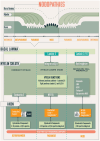Pathology explains various mechanisms of auto-immune inflammatory peripheral neuropathies
- PMID: 37356965
- PMCID: PMC10901618
- DOI: 10.1111/bpa.13184
Pathology explains various mechanisms of auto-immune inflammatory peripheral neuropathies
Abstract
Autoimmune neuropathies are a heterogeneous group of rare and disabling diseases in which the immune system is thought to target antigens in the peripheral nervous system: they usually respond to immune therapies. Guillain-Barré syndrome is divided into several subtypes including "acute inflammatory demyelinating polyradiculoneuropathy," "acute motor axonal neuropathy," "acute motor sensory neuropathy," and other variants. Chronic forms such as chronic inflammatory demyelinating polyneuropathy (CIDP) and other subtypes and polyneuropathy associated with IgM monoclonal gammopathy; autoimmune nodopathies also belong to this group of auto-immune neuropathies. It has been shown that immunoglobulin G from the serum of about 30% of CIDP patients immunolabels nodes of Ranvier or paranodes of myelinated axons. Whatever the cause of myelin damage of the peripheral nervous system, the initial attack on myelin by a dysimmune process may begin either at the internodal area or in the paranodal and nodal regions. The term "nodoparanodopathy" was first applied to some "axonal Guillain-Barré syndrome" subtypes, then extended to cases classified as CIDP bearing IgG4 antibodies against paranodal axoglial proteins. In these cases, paranodal dissection develops in the absence of macrophage-induced demyelination. In contrast, the mechanisms of demyelination of other dysimmune neuropathies induced by macrophages are unexplained, as no antibodies have been identified in such cases. The main objective of this presentation is to show that the pathology illustrates, confirms, and may explain such mechanisms.
Keywords: internode; myelin; neurofascin; node; nodoparanodopathy; paranode.
© 2023 The Authors. Brain Pathology published by John Wiley & Sons Ltd on behalf of International Society of Neuropathology.
Conflict of interest statement
The authors declare no conflict of interest.
Figures






Similar articles
-
Ultrastructural Lesions of Nodo-Paranodopathies in Peripheral Neuropathies.J Neuropathol Exp Neurol. 2020 Mar 1;79(3):247-255. doi: 10.1093/jnen/nlz134. J Neuropathol Exp Neurol. 2020. PMID: 31923310 Review.
-
Clinical and pathophysiological implications of autoantibodies in autoimmune neuropathies.Rev Neurol (Paris). 2023 Oct;179(8):831-843. doi: 10.1016/j.neurol.2023.02.064. Epub 2023 Mar 10. Rev Neurol (Paris). 2023. PMID: 36907709 Review.
-
Paranodal dissection in chronic inflammatory demyelinating polyneuropathy with anti-neurofascin-155 and anti-contactin-1 antibodies.J Neurol Neurosurg Psychiatry. 2017 Jun;88(6):465-473. doi: 10.1136/jnnp-2016-314895. Epub 2017 Jan 10. J Neurol Neurosurg Psychiatry. 2017. PMID: 28073817
-
Antibody- and macrophage-mediated segmental demyelination in chronic inflammatory demyelinating polyneuropathy: clinical, electrophysiological, immunological and pathological correlates.Eur J Neurol. 2020 Apr;27(4):692-701. doi: 10.1111/ene.14133. Epub 2019 Dec 22. Eur J Neurol. 2020. PMID: 31769579
-
Ultrastructural mechanisms of macrophage-induced demyelination in CIDP.Neurology. 2018 Dec 4;91(23):1051-1060. doi: 10.1212/WNL.0000000000006625. Epub 2018 Nov 14. Neurology. 2018. PMID: 30429275 Review.
Cited by
-
Rehabilitation of Peripheral Neuropathies: From Lexical Analysis of the Literature to Identification of Clinical Protocols.J Clin Med. 2023 Sep 10;12(18):5879. doi: 10.3390/jcm12185879. J Clin Med. 2023. PMID: 37762819 Free PMC article. Review.
-
The Potential Role of Adipose-Derived Stem Cells in Regeneration of Peripheral Nerves.Neurol Int. 2025 Feb 6;17(2):23. doi: 10.3390/neurolint17020023. Neurol Int. 2025. PMID: 39997654 Free PMC article. Review.
-
Meeting report of the 20th International Congress of Neuropathology (ICN) 2023 in Berlin.Brain Pathol. 2024 Mar;34(2):e13249. doi: 10.1111/bpa.13249. Brain Pathol. 2024. PMID: 38417806 Free PMC article. No abstract available.
-
The Discovery of Autoimmune Nodopathies and the Impact of IgG4 Antibodies in Autoimmune Neurology.Neurol Neuroimmunol Neuroinflamm. 2025 Jan;12(1):e200365. doi: 10.1212/NXI.0000000000200365. Epub 2024 Dec 13. Neurol Neuroimmunol Neuroinflamm. 2025. PMID: 39671536 Free PMC article. Review.
-
Super-resolution of nodal and paranodal disruption in anti-pan-neurofascin-associated autoimmune nodopathy.Front Immunol. 2025 Feb 20;16:1540859. doi: 10.3389/fimmu.2025.1540859. eCollection 2025. Front Immunol. 2025. PMID: 40051618 Free PMC article.
References
Publication types
MeSH terms
Substances
LinkOut - more resources
Full Text Sources
Medical
Molecular Biology Databases

